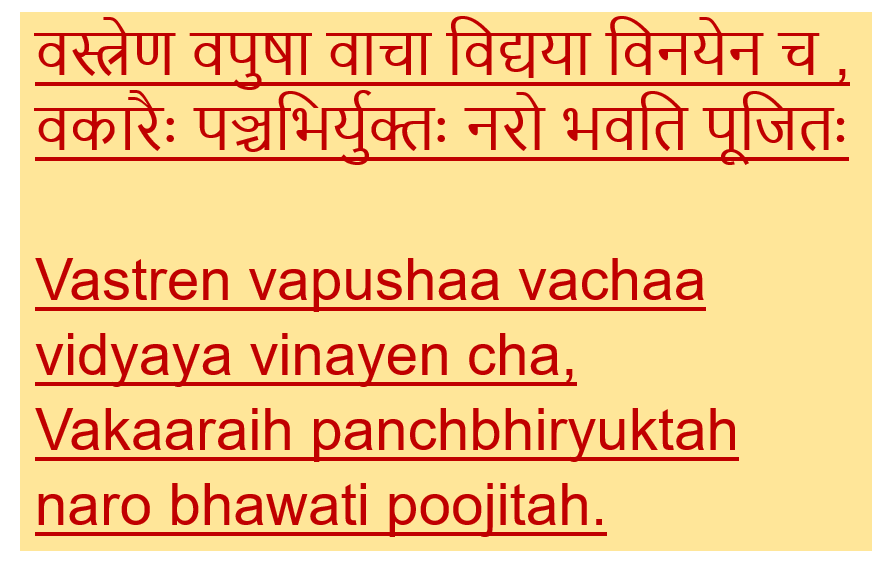
Image Shloka
वस्त्रेण वपुषा वाचा विद्यया विनयेन च ,
वकारैः पञ्चभिर्युक्तः नरो भवति पूजितः
Vastren vapushaa vachaa vidyaya vinayen cha,
Vakaaraih panchbhiryuktah naro bhawati poojitah.
This Sanskrit shloka is from Harishchandra’s era of mythology and also mentioned in Shri Vishnu Sahsranamam. It’s an Epigrammatic Philosophy of Eastern World.
The ABCDE of Image management as we all know, is Appearance, Behaviour, Communication, Digital footprint and Etiquette/Emotional Balance. These 5 resources, if in perfect alignment of our goals, dreams, personality, values, and lifestyle helps us create an authentic image of ourselves.
First Sanskrit word Vastra in the shloka means clothes, dress. Appearance naturally deals with the clothes that you wear. Your clothing should fit well, be in good repair, laundered as necessary, color- and pattern-coordinated and something that is in sync with the message you wish to deliver. Again, a distracting dress can be a liability. Hence use this tool judiciously. Don’t have an extravagant and appealing or an appalling dress. Have a simple and decent one. Remember that the dress is the first pull for the audience and a neat and distraction free dress can establish that basic connect for you.
Second Sanskrit word Vapushaa in shloka means physical built up of a person, rather the body language, non-verbal cues, being conscious of what our body is telling others and what theirs is telling us, it actually also means appearance. In this specific context I would like to call it as the way you use the dais. Standing at one corner and delivering a speech might not be the best way to deliver a speech. You ought to move across the stage. As you own and walk across the dais, display elegance, your body needs to convey to the audience that you actually are enjoying experience and this makes them more receptive to you.
Then Sanskrit word Vaacha in shloka means manner of speaking, the third resource of image management – Communication – What You Say & How You Say It. The voice/tone of the speaker must be sweet and it should be something that the audience like and identify themselves with. That does not mean, it must be a sing song voice or so. All to say is that harshness in the voice might switch people off. Should one speak harshly and in a domineering way we would obviously lose interest, wouldn’t we? A shrill voice, a fast-paced speech and a queer pitch too, will kill a speech and would turn the audience off. Hence maintaining a good tone, pace and pitch for the speech are extremely important.
The 70/20/10 rule to follow, which means that communication is:
70% body language
20% tone of voice
10% the actual words you use
Here we can see, Sanskrit word Vapushaa and Vaacha in the shloka is the third resource of image management Communication, which includes body language, i.e., non-verbal cues and verbal communication
The fourth and very important Sanskrit word in shloka is Vidya, don’t take vidya as education in this case. Take it to be knowledge. Once the audience realize that you are looking good and enjoying your stage time, they would definitely look for the content you speak. How well you speak depends on how learned you are, hence reading well a recollecting that content well is of primordial importance in your speech. One needs to read well, acquire skills, facts, and information through education or experience. Read fiction, non-fiction and classics when one has time. Learning new things in life can be a huge stepping stone in achieving the goals we have in mind. All this would help one handle any topic very easily. Read more and read wide.
The last and most important one in Sanskrit shloka above is “Vinaya”. As we all know Vinaya would mean humility. Vinaya also means courteous, being courteous means showing regard or thought for others; especially, displaying good manners or etiquette, this is the 5th resource of image management, i.e., etiquette. Having good clothes, nice appearance and a good voice and a good education are all blessings we have in our lives and we ought to count them. There are many people out there who do not have any of these. Shouldn’t we be thankful to the Almighty and our parents who gave all these to us. The greatest of the orators were humble souls to begin with. A Gandhi, A Mandela, A Swami Vivekananda or a Martin Luther King were all humble when they addressed the masses and we all know the impact they had on the people who heard to them. Let’s make humility our second nature and not restrict it to the speeches alone. Forget the speeches this one quality can take us places.
Sanskrit word Panchbhiryuktah means = Panchabhi + Yukta.
Panchabhi = these five, Yuktah = having, including. (here it denotes that all these five words start with the alphabet ‘va’)
Sanskrit word Naro in shloka means people, persons as well Bhawati means happens and Poojitah means adored, respected.
Once again reiterating the Sanskrit shloka for putting all five alphabets ‘व ‘ “Va’s” together —
वस्त्रेण वपुषा वाचा विद्यया विनयेन च,
वकारैः पञ्चभिर्युक्तः नरो भवति पूजितः
Overall to summarize the shloka in Brief –A person is respected and adored in society if he has these five attributes, their names starting with the alphabet ‘व ‘ -‘va’ -namely
- being well dressed
- having a good physique
- having a proper diction (manner of speaking) ,
- being learned and
- courteous.
Except the fourth resource of Image management i.e., Digital foot print, which was not there in that era, all other resources of Image management – Appearance, Behaviour, communication and etiquette is covered in the Sanskrit shloka.
This shows how image management is deep rooted in our ancient mythology and only awareness with conscience implementation is the necessity to achieve our goals in life, in turn creating authentic image of ourselves.
Ending with a quote in Bhavatgita, to live a respected life in the society —

References —